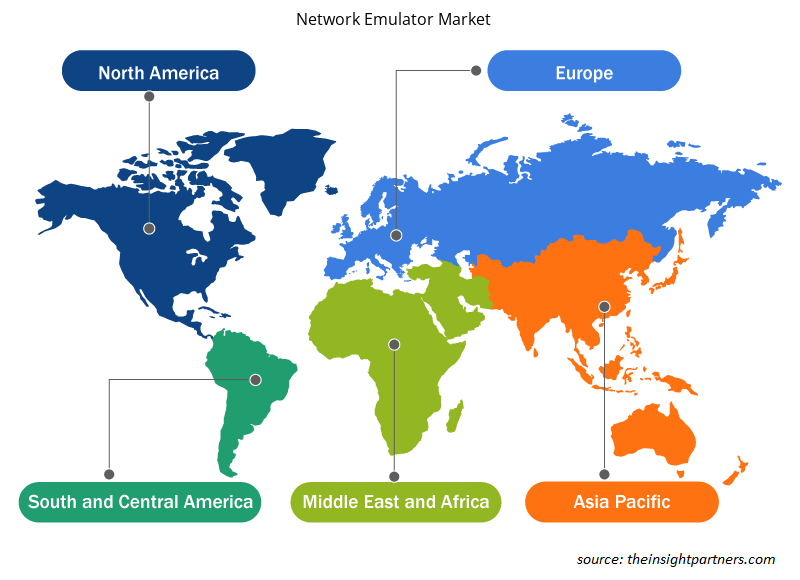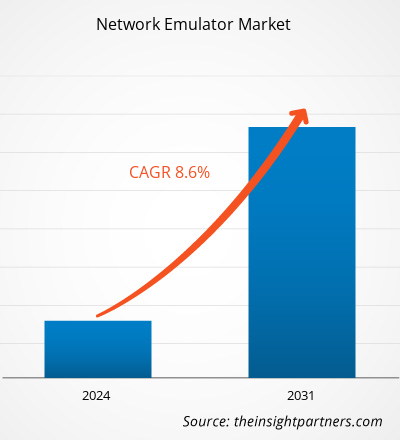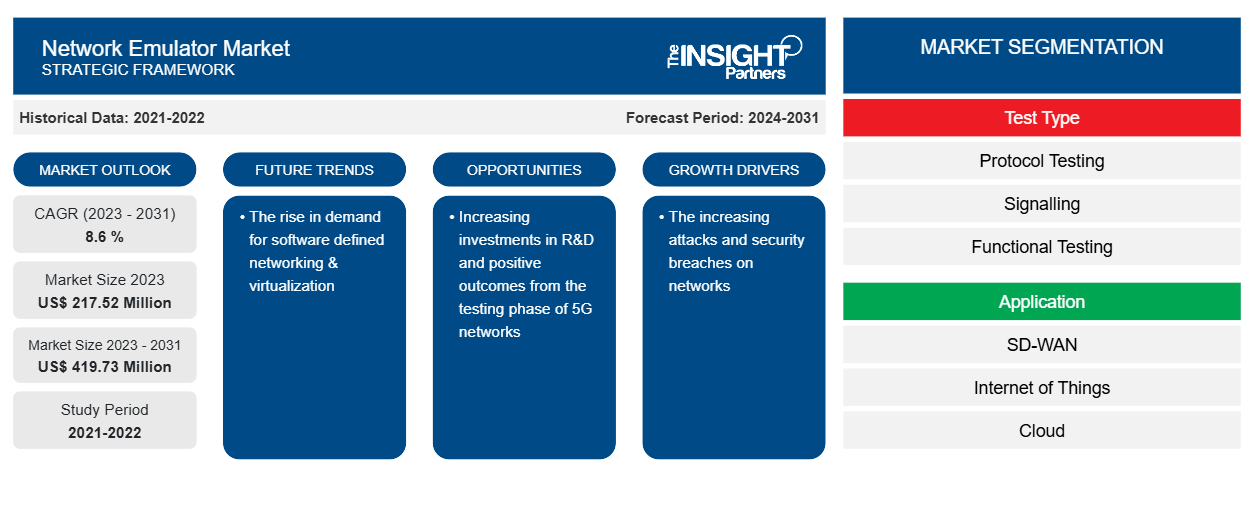Si prevede che la dimensione del mercato degli emulatori di rete raggiungerà i 419,73 milioni di dollari entro il 2031, rispetto ai 217,52 milioni di dollari del 2023. Si prevede che il mercato registrerà un CAGR dell'8,6% nel 2023-2031. È probabile che l'aumento della domanda di reti e virtualizzazione definite dal software rimanga una tendenza chiave del mercato degli emulatori di rete.CAGR of 8.6 % in 2023–2031. The rise in demand for software-defined networking & virtualization is likely to remain a key network emulator market trend.
Analisi di mercato degli emulatori di rete
Grazie alla digitalizzazione diffusa, le organizzazioni stanno migrando sempre di più verso infrastrutture basate su cloud, il che le spinge a utilizzare soluzioni di emulazione di rete per verificare le prestazioni di rete e la qualità del servizio. L'aumento degli attacchi informatici è un altro fattore che spinge la crescita del mercato. Prima che una rete venga finalmente implementata, gli emulatori di rete testano e convalidano la sua infrastruttura, migliorano le sue prestazioni e riducono al minimo i tempi di inattività. I fornitori di servizi di telecomunicazioni stanno utilizzando sistemi di test e emulazione di rete robusti a causa dell'aumento del traffico di rete e delle interruzioni, nonché dell'attuale domanda in espansione di servizi di rete 5G. Possono testare i dispositivi SG e le stazioni base prima dell'implementazione finale con l'uso di tecnologie di emulazione di rete. Si prevede che ciò sarà fondamentale per aprire nuove porte al mercato degli emulatori di rete.
Panoramica del mercato degli emulatori di rete
L'emulazione di rete è il processo di utilizzo di strumenti di rete virtuali, o emulatori di rete, per testare le prestazioni di diverse applicazioni in tempo reale. I provider di servizi, gli sviluppatori di applicazioni e i produttori utilizzano l'emulazione di rete per testare l'affidabilità di un'applicazione o di un prodotto di rete. Gli emulatori di rete sono dotati di routing, filtraggio, compromissioni e modificatori come funzionalità standard. A differenza delle simulazioni di rete, queste emulazioni sono rappresentazioni matematiche dei canali, del traffico, dei protocolli e dei modelli di rete applicati a una rete. Gli obiettivi sono la valutazione delle prestazioni, la previsione dell'impatto delle modifiche e l'ottimizzazione della selezione della tecnologia. Molte caratteristiche di rete comuni sono incluse nei progetti di emulatori di rete, come la duplicazione dei pacchetti, la larghezza di banda disponibile, un certo livello di perdita di pacchetti e il tempo di andata e ritorno tra i pacchetti di riordino della rete.
Personalizza questo report in base alle tue esigenze
Riceverai la personalizzazione gratuita di qualsiasi report, comprese parti di questo report, o analisi a livello nazionale, pacchetto dati Excel, oltre a usufruire di grandi offerte e sconti per start-up e università
-
Scopri le principali tendenze di mercato in questo rapporto.Questo campione GRATUITO includerà analisi di dati che spaziano dalle tendenze di mercato alle stime e alle previsioni.
Driver e opportunità del mercato degli emulatori di rete
I crescenti attacchi e violazioni della sicurezza sulle reti
La crescente prevalenza di soluzioni digitali e dispositivi in rete ha portato a un'ondata di attacchi informatici e violazioni della sicurezza, sottolineando la necessità vitale di test approfonditi delle prestazioni di rete e della sicurezza. I test appropriati diventano cruciali per prevenire i crimini informatici a causa della possibilità di vulnerabilità del prodotto. Gli emulatori di rete sono essenziali perché offrono ambienti virtualizzati per test approfonditi, garantendo la sicurezza di dispositivi e reti in una varietà di circostanze. Le organizzazioni possono risolvere i problemi, migliorare le prestazioni e creare reti resilienti con questa capacità. L'importanza degli emulatori di rete nel rafforzare la sicurezza e difendersi dalle intrusioni diventa un forte fattore motivante per il loro uso più ampio con l'aumento delle minacce informatiche.cybercrimes because of the possibility of product vulnerabilities. Network emulators are essential because they offer virtualized environments for extensive testing, guaranteeing the safety of devices and networks under a variety of circumstances. Organizations can troubleshoot, enhance performance, and create resilient networks with this capability. The importance of network emulators in strengthening security and defending against intrusions becomes a strong motivator for their wider use as cyber threats rise.
Aumento degli investimenti in R&S e risultati positivi dalla fase di test delle reti 5G
La necessità di dati e servizi mobili è in aumento con l'avanzare della tecnologia 5G. Le industrie assisteranno a una crescita significativa nella comunicazione machine-to-machine (M2M), che aumenterà la necessità di una copertura di rete rapida ed estesa. Inoltre, ciò presenterà un potenziale globale significativo per dispositivi e emulatori di test di rete. Si prevede che un certo numero di nazioni significative, tra cui Stati Uniti, Regno Unito, Giappone, Corea del Sud, Germania e Cina, creeranno e implementeranno reti e apparecchiature wireless 5G entro il 2024. A causa dell'enorme aumento di utenti mobili che ne deriverebbe, sarebbe necessaria un'infrastruttura in grado di mantenere la connettività anche nelle circostanze più avverse. Gli investimenti in soluzioni di rete vengono effettuati in grandi quantità da fornitori di servizi di comunicazione (CSP) e aziende di rete. Ad esempio, Huawei ha effettuato investimenti significativi nella creazione di reti e gadget 5G. Pertanto, si prevede che i crescenti investimenti in R&S e i risultati positivi della fase di test delle reti 5G presenteranno nuove opportunità per gli operatori del mercato degli emulatori di rete durante il periodo di previsione.
Analisi della segmentazione del rapporto di mercato degli emulatori di rete
I segmenti chiave che hanno contribuito alla derivazione dell'analisi di mercato degli emulatori di rete sono il tipo di test, l'applicazione e il settore verticale.
- In base al tipo di test, il mercato degli emulatori di rete è segmentato in test di protocollo, segnalazione e test funzionale . Il segmento dei test di protocollo ha detenuto una quota di mercato maggiore nel 2023.
-
Per applicazione, il mercato è segmentato in SD-WAN, Internet of Things, cloud e altri
- In base al settore verticale, il mercato è segmentato in governo e difesa, commercio al dettaglio e commercio elettronico, BFSI, sanità, telecomunicazioni e altri.
Analisi della quota di mercato degli emulatori di rete per area geografica
L'ambito geografico del report di mercato degli emulatori di rete è suddiviso principalmente in cinque regioni: Nord America, Asia Pacifico, Europa, Medio Oriente e Africa e Sud America/Sud e Centro America. In termini di fatturato, l'APAC ha rappresentato la quota di mercato degli emulatori di rete più grande. A causa del crescente sviluppo e implementazione di reti e applicazioni mobili 5G, che stanno guidando nuovi investimenti in telecomunicazioni, infrastrutture e applicazioni all'avanguardia come realtà aumentata e veicoli autonomi, si prevede che l'APAC sperimenterà la crescita più rapida in questo mercato.
Approfondimenti regionali sul mercato degli emulatori di rete
Le tendenze regionali e i fattori che influenzano il mercato degli emulatori di rete durante il periodo di previsione sono stati ampiamente spiegati dagli analisti di Insight Partners. Questa sezione discute anche i segmenti e la geografia del mercato degli emulatori di rete in Nord America, Europa, Asia Pacifico, Medio Oriente e Africa e America meridionale e centrale.

- Ottieni i dati specifici regionali per il mercato degli emulatori di rete
Ambito del rapporto di mercato degli emulatori di rete
| Attributo del report | Dettagli |
|---|---|
| Dimensioni del mercato nel 2023 | 217,52 milioni di dollari USA |
| Dimensioni del mercato entro il 2031 | 419,73 milioni di dollari USA |
| CAGR globale (2023-2031) | 8,6% |
| Dati storici | 2021-2022 |
| Periodo di previsione | 2024-2031 |
| Segmenti coperti |
Per tipo di test
|
| Regioni e Paesi coperti |
America del Nord
|
| Leader di mercato e profili aziendali chiave |
|
Densità dei player del mercato degli emulatori di rete: comprendere il suo impatto sulle dinamiche aziendali
Il mercato degli emulatori di rete sta crescendo rapidamente, spinto dalla crescente domanda degli utenti finali dovuta a fattori quali l'evoluzione delle preferenze dei consumatori, i progressi tecnologici e una maggiore consapevolezza dei vantaggi del prodotto. Con l'aumento della domanda, le aziende stanno ampliando le loro offerte, innovando per soddisfare le esigenze dei consumatori e capitalizzando sulle tendenze emergenti, il che alimenta ulteriormente la crescita del mercato.
La densità degli operatori di mercato si riferisce alla distribuzione di aziende o società che operano in un particolare mercato o settore. Indica quanti concorrenti (operatori di mercato) sono presenti in un dato spazio di mercato in relazione alle sue dimensioni o al valore di mercato totale.
Le principali aziende che operano nel mercato degli emulatori di rete sono:
- Tecnologie Apposte
- Sistemi Aukua Inc.
- Società a responsabilità limitata
- InterWorking Labs, Inc.
- ltrinegia
- Tecnologie Keysight
Disclaimer : le aziende elencate sopra non sono classificate secondo un ordine particolare.

- Ottieni la panoramica dei principali attori del mercato degli emulatori di rete
Notizie di mercato e sviluppi recenti degli emulatori di rete
Il mercato degli emulatori di rete viene valutato raccogliendo dati qualitativi e quantitativi post-ricerca primaria e secondaria, che includono importanti pubblicazioni aziendali, dati di associazioni e database. Di seguito è riportato un elenco degli sviluppi nel mercato dei disturbi e delle strategie del linguaggio e della parola:
- Ad aprile 2024, ALifecom ha annunciato il rilascio della sua piattaforma IoT Non-Terrestrial Networks. Questa piattaforma è la prima soluzione integrata del settore che incorpora un emulatore di canale nell'emulatore di rete NE6000 di ALifecom per simulare e testare efficacemente le comunicazioni NTN all'interno di una soluzione di piccole dimensioni, intuitiva e conveniente. (Fonte: ALifecom, comunicato stampa)
- Nel maggio 2023, Gatehouse Satcom ha creato un gemello digitale che offre un'emulazione virtuale dinamica della rete satellitare fisica di Inmarsat, che ha un aspetto e un comportamento identici alla sua controparte nel mondo reale. (Fonte: Gatehouse Satcom, comunicato stampa)
Copertura e risultati del rapporto sul mercato degli emulatori di rete
Il rapporto "Dimensioni e previsioni del mercato degli emulatori di rete (2021-2031)" fornisce un'analisi dettagliata del mercato che copre le seguenti aree:
- Dimensioni e previsioni del mercato a livello globale, regionale e nazionale per tutti i segmenti di mercato chiave coperti dall'ambito
- Dinamiche di mercato come fattori trainanti, vincoli e opportunità chiave
- Principali tendenze future
- Analisi dettagliata delle cinque forze PEST/Porter e SWOT
- Analisi di mercato globale e regionale che copre le principali tendenze di mercato, i principali attori, le normative e gli sviluppi recenti del mercato
- Analisi del panorama industriale e della concorrenza che copre la concentrazione del mercato, l'analisi della mappa di calore, i principali attori e gli sviluppi recenti
- Profili aziendali dettagliati
- Analisi storica (2 anni), anno base, previsione (7 anni) con CAGR
- Analisi PEST e SWOT
- Valore/volume delle dimensioni del mercato - Globale, Regionale, Nazionale
- Industria e panorama competitivo
- Set di dati Excel
Report recenti
Testimonianze
Motivo dell'acquisto
- Processo decisionale informato
- Comprensione delle dinamiche di mercato
- Analisi competitiva
- Analisi dei clienti
- Previsioni di mercato
- Mitigazione del rischio
- Pianificazione strategica
- Giustificazione degli investimenti
- Identificazione dei mercati emergenti
- Miglioramento delle strategie di marketing
- Aumento dell'efficienza operativa
- Allineamento alle tendenze normative























 Ottieni un campione gratuito per - Mercato degli emulatori di rete
Ottieni un campione gratuito per - Mercato degli emulatori di rete